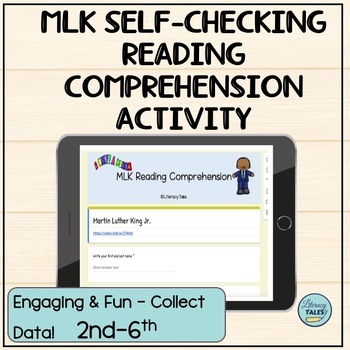Martin Luther King No PREP Self-Checking Google Form
- Google Forms™

Also included in
- No Prep Reading Comprehension Questions (Story Elements ) Google Forms. No Prep or Grading. Save time, assign it to Google Classroom or your Digital Platform, and allow your students to practice reading skills. This resource is perfect for teachers looking for an easy way to assess their studentPrice $51.00Original Price $51.00
Description
Martin Luther King Jr, No PREP Self-Checking Google Form. This is a Google Form to assess students' reading skills and knowledge about MLK. Martin Luther King's Google Form includes 10 questions about the character, events, problem, and outcomes and a bonus question for extra credit. Save time, Upload it to a Google Platform, and collect grades and data.
It can be used with 2nd- 5th graders. Answers have already been created and added to the form.
The 10 questions are based on the book to assess students' understanding of the historical event.
A link to the story is provided if you don't have the book.
A Picture Book of Martin Luther King, Jr. By David A Adler
Don't delay – unlock the potential of your classroom with our No Prep Reading, Writing, and Vocabulary packet today!
⭐Reading Comprehension Google Form Growing Bundle
I have used it in the classroom with my students. It has been a time saver.
First, make sure you link the form to the Excel spreadsheet. If you have already purchased a previous reading comprehension, Google Forms does not create a new spreadsheet. Just link this form to the old reading comprehension spreadsheet. Pictures accompany most questions to help students choose the right answer.
You will create a tab for each test by following the following steps. You will also create a data sheet and save all the grades in one place.
Watch my video on Instagram to follow the steps to link the Google Form to the Excel sheet.
Then, share the link with your students. You can post it on Google Classroom or send it in the chat via your virtual platform.
-Students open the link you read, or they can listen to the story before or during the assessment.
- Students start taking the test. When they are done, they hit the submit button. Scores will be uploaded to your Excel sheet. It will include the average for each student.
The Benefit of Self-Grading Tests:
1- Completely Self -Grading
2-Paperless
3-Immediate Student Feedback
4-Easy to Analyze Results
5-Data Collection
Again, I emphasize Self- Grading.
Try Reading Comprehension Google Forms Risk-Free: Freebie Google Form.
⤏⤏⤏⤏⤏⤏⤏⤏⤏⤏⤏⤏⤏⤏⤏⤏⤏⤏⤏⤏⤏⤏⤏⤏⤏⤏⤏⤏⤏⤏⤏⤏⤏⤏⤏⤏⤏⤏⤏⤏
Thank you so much for your support and wonderful feedback!
Click Here to be the first to know about my store-wide sales, freebies, and new products.
Follow me on social media:
Click here for more fun digital resources!
Keywords: Word Search, Reading comprehension, Google Forms, Sound Tap & Write (Phonics)
Thank you so much for all you do for students as educators!
M. Tehfe
Literacy Tales
Where Stories Come Alive✎






